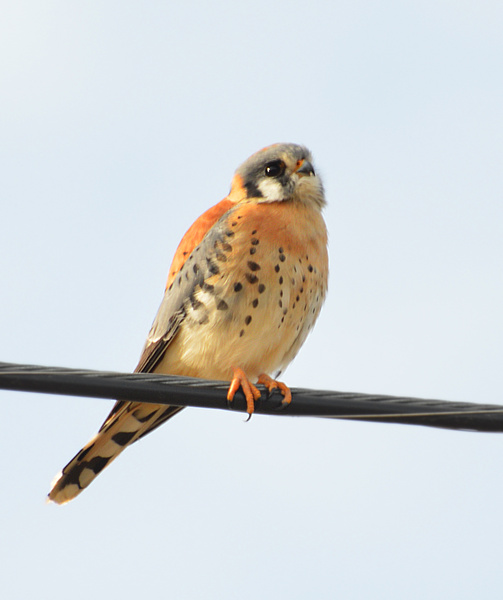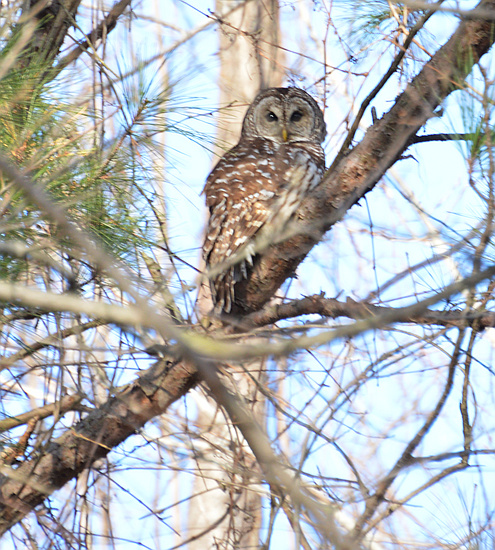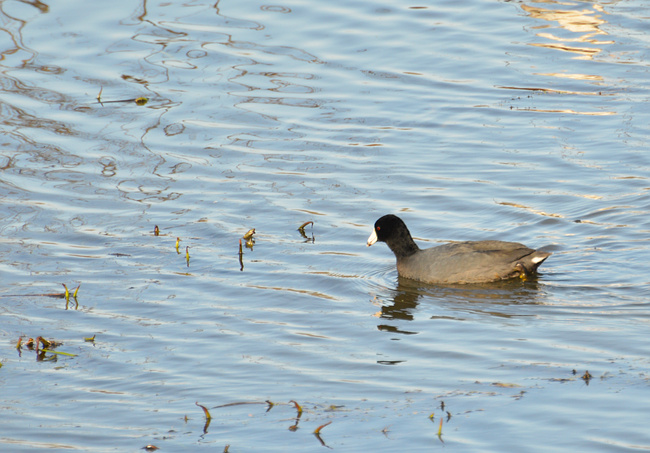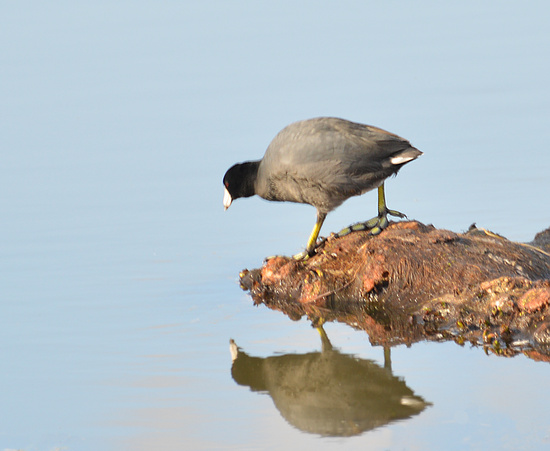
In Love With Dutch Gap (part 3)
January 23rd, 2018
On the 27th Michael and I made one final outing to Dutch Gap, featuring three exciting photographic firsts: three birds that I had either never photographed before, or never photographed well. None of them were ducks, oddly enough!
The first was this beautiful little falcon, an American Kestrel:

While I've seen kestrels often enough, usually in rural areas, they always seem to fly away before I can take a picture. I photographed this one from the car and managed to get a few good shots in before he spooked.
For the second photographic first, I thank the very cold weather that day (even colder than the last), which was slowing down the hyperactive kinglets. This is the first photo I've ever gotten of a Golden-Crowned Kinglet that I'm happy with. Though it may not look it in the close-up, this bird is even tinier than the Ruby-Crowned Kinglet pictured in the previous post.

The third first involved the undisputed high point of our outing, a magnificent Barred Owl. The photos don't do it justice, but they are my first-ever showable photos of the species. (I only wish I'd had my camera with me when I saw one of these beauties a few winters back in the Gatineau, almost close enough to touch!)


Even though it is a common species, of the nine owls on my lifelist, Barred is my favorite. I love its dark, brooding eyes and its strange call.

American Coot

American Coot
Another things that gives coots away as non-ducks: their weird feet.

White-Throated Sparrow
There's something unusual about the White-Throated Sparrow. If you'd like to know the story, read on.
A common arrangement among birds is that males take the lead in courtship and territorial defense, while females take the lead in nest-building and nurturing the young. In these species the male often has a highly ornamental plumage, designed for attracting females' attention and making a visual statement to other males, while the female has a drabber plumage designed for camouflage, so that she won't draw undue attention to the helpless chicks/eggs. At the extreme you get most duck species, wherein the flashy male leaves the premises entirely before his ducklings are even born. (If he doesn't do so voluntarily, the female will actually drive him away.)
In some species, gender roles are less disjunct and both parents are heavily invested in the rearing of the young. Geese for instance. In such species, males and females typically look identical to each other.
And then, in a very few types of birds, the roles are disjunct but reversed. Phalaropes (those spinning birds I mentioned two posts back) are one example. Female phalaropes compete for males and defend a territory while males do all the incubation and chick-rearing. In these role-reversed species the females are the ones with the more eye-catching plumage.
Then there's the White-Throated Sparrows. When nature asked White-Throated Sparrows "do you want to be like the ducks, the geese, or the phalaropes?", White-Throated Sparrows said "none of the above." They have two plumage morphs, one with white stripes on top of the head, the other with tan stripes. The tan-striped birds have a more muted appearance; the white-striped ones are more eye-catching. And the same genes that select for this difference in appearance create differences in behavior. White-Striped WTS's are more aggressive and territorial (and better singers); tan-striped ones do a better job at caring for young.
The optimal balance is one of each. You can see how a pair of white-stripes might lose their chicks to a hungry crow while out squabbling with their neighbors (or having sex with their neighbors: the white-stripes are also more prone to fooling around.) Meanwhile a pair of tan-stripes would produce a very well-nurtured, well-protected nest of young, but have no ability to hold their own in terms of territory. So a white-striped WTS almost always chooses a tan-striped WTS as its mate, and vice versa. They know instinctively to pick the opposite type from themselves. The end result is very like the typical sex roles found in many other birds, but running along a line orthogonal to biological sex. They effectively evolved two new genders. Why? See here for some fascinating reading on the subject.
January 23rd, 2018
On the 27th Michael and I made one final outing to Dutch Gap, featuring three exciting photographic firsts: three birds that I had either never photographed before, or never photographed well. None of them were ducks, oddly enough!
The first was this beautiful little falcon, an American Kestrel:

While I've seen kestrels often enough, usually in rural areas, they always seem to fly away before I can take a picture. I photographed this one from the car and managed to get a few good shots in before he spooked.
For the second photographic first, I thank the very cold weather that day (even colder than the last), which was slowing down the hyperactive kinglets. This is the first photo I've ever gotten of a Golden-Crowned Kinglet that I'm happy with. Though it may not look it in the close-up, this bird is even tinier than the Ruby-Crowned Kinglet pictured in the previous post.

The third first involved the undisputed high point of our outing, a magnificent Barred Owl. The photos don't do it justice, but they are my first-ever showable photos of the species. (I only wish I'd had my camera with me when I saw one of these beauties a few winters back in the Gatineau, almost close enough to touch!)


Even though it is a common species, of the nine owls on my lifelist, Barred is my favorite. I love its dark, brooding eyes and its strange call.

American Coot

American Coot
Another things that gives coots away as non-ducks: their weird feet.

White-Throated Sparrow
There's something unusual about the White-Throated Sparrow. If you'd like to know the story, read on.
A common arrangement among birds is that males take the lead in courtship and territorial defense, while females take the lead in nest-building and nurturing the young. In these species the male often has a highly ornamental plumage, designed for attracting females' attention and making a visual statement to other males, while the female has a drabber plumage designed for camouflage, so that she won't draw undue attention to the helpless chicks/eggs. At the extreme you get most duck species, wherein the flashy male leaves the premises entirely before his ducklings are even born. (If he doesn't do so voluntarily, the female will actually drive him away.)
In some species, gender roles are less disjunct and both parents are heavily invested in the rearing of the young. Geese for instance. In such species, males and females typically look identical to each other.
And then, in a very few types of birds, the roles are disjunct but reversed. Phalaropes (those spinning birds I mentioned two posts back) are one example. Female phalaropes compete for males and defend a territory while males do all the incubation and chick-rearing. In these role-reversed species the females are the ones with the more eye-catching plumage.
Then there's the White-Throated Sparrows. When nature asked White-Throated Sparrows "do you want to be like the ducks, the geese, or the phalaropes?", White-Throated Sparrows said "none of the above." They have two plumage morphs, one with white stripes on top of the head, the other with tan stripes. The tan-striped birds have a more muted appearance; the white-striped ones are more eye-catching. And the same genes that select for this difference in appearance create differences in behavior. White-Striped WTS's are more aggressive and territorial (and better singers); tan-striped ones do a better job at caring for young.
The optimal balance is one of each. You can see how a pair of white-stripes might lose their chicks to a hungry crow while out squabbling with their neighbors (or having sex with their neighbors: the white-stripes are also more prone to fooling around.) Meanwhile a pair of tan-stripes would produce a very well-nurtured, well-protected nest of young, but have no ability to hold their own in terms of territory. So a white-striped WTS almost always chooses a tan-striped WTS as its mate, and vice versa. They know instinctively to pick the opposite type from themselves. The end result is very like the typical sex roles found in many other birds, but running along a line orthogonal to biological sex. They effectively evolved two new genders. Why? See here for some fascinating reading on the subject.
| ← | → |

Mike
January 24th, 2017 at 2:02 pm
Sadly, "coot foot" doesn't rhyme, because English.
I see what you mean about the owl photos... they just don't have the clarity, probably because the camera changed ISO on you--I remember the owl being more shadowed.
The kinglet photo is very good, rather Christmasy.
The Merlin shots are great, the second one being particularly arresting.
Suzanne
January 24th, 2018 at 2:21 pm
"arresting"...that's one way to describe that intense eye contact :-)
Re owl, it's not the camera's fault in that sense because I run everything on manual. I think the real problem was a combination of taking the photo in the late afternoon (the late afternoon lighting is always difficult I find), and there being many, many intervening twigs between me and the owl. There were so many twigs they had a blurring effect.
mustangsallie
January 27th, 2018 at 12:00 pm
Good shot of the Falcon. It is a beautifully colored bird. The second (frontal) shot of the Barred Owl is great with it's hauntingly intense stare, and the story accompanying the White Throated Sparrow is interesting and humorous!